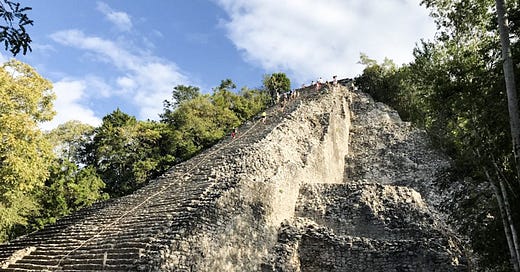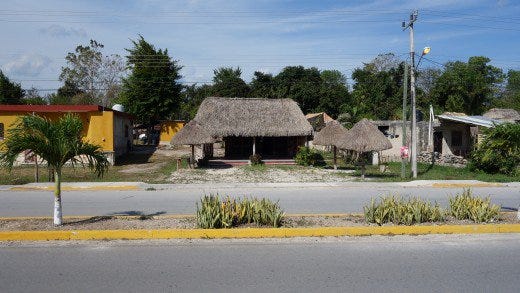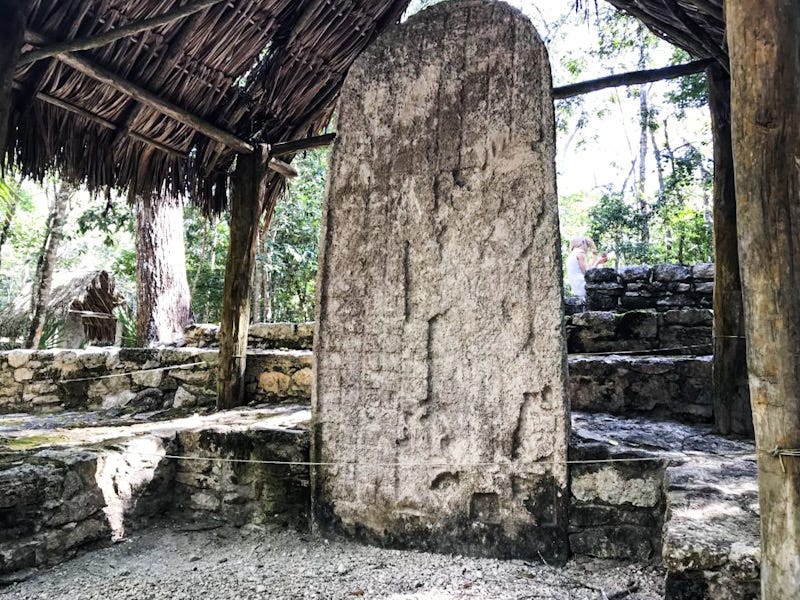Travel and Archaeology: New Discoveries Influence Our Desire to Travel to Some Places
New stela discovered in the ancient Maya site of Cobá in Yucatan, Mexico, prompts us to rethink our resolve of staying away from the area - Letters from a Wanderer No 20
Hello everyone and welcome new subscribers!
I bring you an extra post today, since I wanted to share some news I just read about a stela found in Cobá Archaeological Zone, home of the ancient Maya, in today’s Quintana Roo, a state on Mexico’s Yucatan Peninsula.
Why do I care about this news, you may wonder, or why should you care? I find it interesting and hope you do, too.
I find anything related to archaeology, and to the ancient Maya, fascinating. Learning about and wandering through the vestiges of an ancient civilization makes me feel connected to the past, to a larger picture of humanity, adding a new dimension to a place. It also offers an insight into the lives of people who lived long before us, but had the same basic needs and challenges; I find it fascinating to walk on the same ground they did.
On my site, Wanderer Writes, I often write about our adventures in the land of the Maya, a place we’ve been visiting and revisiting for over three decades. And of all the places we love there, Cobá has a special place in our hearts. In fact, we often considered moving there. But even without living there full time, the town started to feel like home over time.
The town’s dogs roaming the streets freely who often accompanied us to the top of the highest pyramid, Nohuch Mul, the crocodiles, turtles, and fishes in Lake Cobá, the local Maya ladies greeting me along the more remote streets, and kids on their way home from school showing us crocodiles in the lake, and especially the ancient structures in the archaeological zone all add to a feeling of home away from home when we are there.
Looking up to the ancient Iglesia, the first structure you notice as you enter the archaeological site, I remember climbing it and walking through its rooms filled with bats. You can’t do it now, but years ago, when we first visited, we used to be alone at the site that had no restrictions on climbing any structures. Even now, with crowds of visitors, and most structures closed to climbing, the site still feels like home.
We feel we know every corner of the site, every structure, every tree, every stela. And yet, over the years, we often came across more extensively excavated structures, new uncovered buildings and stelae. We’ve always known that it was only a matter of time before archaeologists discover more. In fact, this is one of the major draw for us to revisit these sites, the ongoing excavations, the ongoing learning process about the ancient people who lived there long before us.
As much as we love it though, after our latest visit this past January, we decided we would not return to the Yucatan, not even for revisiting Cobá. We felt the Maya Train was ruining everything we loved about it.
But that was before I noticed the news about the new stela discovered a few days ago. Now, I am sure we will plan another trip.
My introduction to the ancient Maya sites came when I met my husband, who was fascinated by them. By the time I met him, he had visited several sites in Mexico and Guatemala, and attended a Maya Workshop at the University of Pennsylvania. His collection of books included just about every professional book published about the ancient Maya at the time, from discovering the ruins of their cities to their history and study of their writing system.
These books were some of the first I read on the subject, and it wasn’t long before I was as excited about this ancient civilization as he was. So, naturally, we chose the Yucatan as a destination for our honeymoon.
After our initial trip in 1995, we kept coming back to the area. First just the two of us, then with our children. As they grew, they climbed pyramids, played with local Maya children, learned to speak a bit of Spanish, and learned about another culture.
Throughout all our travels to this land of the modern and ancient Maya, Cobá always felt special. It was the first site I spent a longer time at, staying overnight in the tiny village on the shores of lake Cobá.
No longer a village, the town somehow hasn’t lost its magic, even as it grew into a major tourist destination. As busy as it gets in the morning and afternoon, after the tour buses leave for the day, Cobá is still a quiet, local Maya town.
The Archaeological Site
One of the largest and oldest of the Maya ruins in Quintana Roo, on the Yucatan peninsula, Cobá owes its notoriety to being home to one of the tallest pyramids on the peninsula, Ixmoja in the Nohuch Mul group.
However, the famous pyramid is only one of hundreds of ancient structures on the site, connected by long trails through the jungle. Besides the pyramids and other structures, Cobá is also home to the largest network of sacbe (ancient stone roads) of the region.
The name of the site, Cobá, means “waters stirred by the wind,” a fitting name considering the site’s location, near two large lagoons, Lake Cobá, and Lake Macanxoc.
Archaeologists believe Cobá was one of the most important city-states on the Yucatan Peninsula.
Though first settled in the Pre-Classic period (300 BC–200 AD) of the Maya civilization, the earliest structures we see at the site date from the Early Classic era (200–600 AD). And by the Late Classic period (600–900 AD) Cobá became a serious power, the regional capital of the area. This was when they built most of its structures we admire today. Home to about 50,000 people, it held a strong cultural and political influence over the surrounding region.
A few years ago I wrote a guide to visit the archaeological site of Cobá, based on our multiple visits and my readings. You can read it by clicking the link below.
Extensive as the site is with the excavated structures, I always knew there would be more discoveries at the site. After all, the whole site of Cobá spreads over 30 square miles.
My husband and I often discussed it, standing on top of Ixmoja pyramid, looking down into the jungle while spotting more mounds we thought might be unearthed structure, or when sitting in the Macanxoc group, the most remote area of the site, filled with ancient stelae.
Stelae is plural for stela, meaning a tall stone shaft carved with images and hieroglyphic texts, found in all ancient Maya sites. They usually talk about historical events, adding the date associated with it, basically ancient history written in stone.
And, since we don’t have many ancient Maya books, or codices remaining, these stelae offer us a glimpse into the ancient history of the Maya. They erected stelae to celebrate events, especially those important for their rulers. The more stelae a ruler erected, the more powerful he or she was.
The longest known (so far) Maya hieroglyphic text carved on stela is on Stela 1 in Cobá, with 313 glyphs on it, carved on the front, back and sides, recording dates from A.D. 653 to 672. However, new discoveries, like the most recent, might unearth longer texts in the future.
The new discovery
Archaeologists from INAH - the National Institute of Anthropology and History of Mexico - unearthed a Maya stela close to the famous Nohuch Mul pyramid in Cobá. The stela is 11 meters (over 30 feet) long and has 123 carved hieroglyphs on it. According to INAH, they seem to describe the founding of the Maya settlement of Keh Witz Nal (Deer Mountain). The inscriptions also mention the name of a previously unknown ruler, K’awiil Ch’ak Chéen, adding to the known rulers of Cobá.
source: Mexico News Daily, August 13, 2024
Someday, I’d love to see this stela. I’m also curious to hear the thoughts of renowned Mayan epigrapher David Stuart and his colleagues. I hope to also write about it and include a photo once they open the area for visits.
For a bit of a background of the ancient Maya, you’ll find Jeanine Kitchell’s post Why the Ancient Maya Remained Steeped in Mystery here on Substack, helpful. She also writes about the Maya, and about her own adventures while living in Puerto Morelos, not far from Cobá.
Or, you can always read my articles about the sites I have visited over the years on Wanderer Writes.
Thank you for reading! Have a wonderful day and if you are on the road, happy travels!
All the best,
Emese
If you liked this post, please let me know either by hitting the “like” button (this will make it easier for others to find it), or sharing it.
You could also subscribe to the newsletter, if you’d like to read more of my posts, to receive them directly in your inbox as soon as they are published. All posts are free to read. Paid subscriptions are only a way to show your appreciation and support my work.
You can also show your appreciation for this post alone (or any individual post) by adding a tip to buy me a coffee.














wow! archeologists are always discovering new things-- this is a great article :)